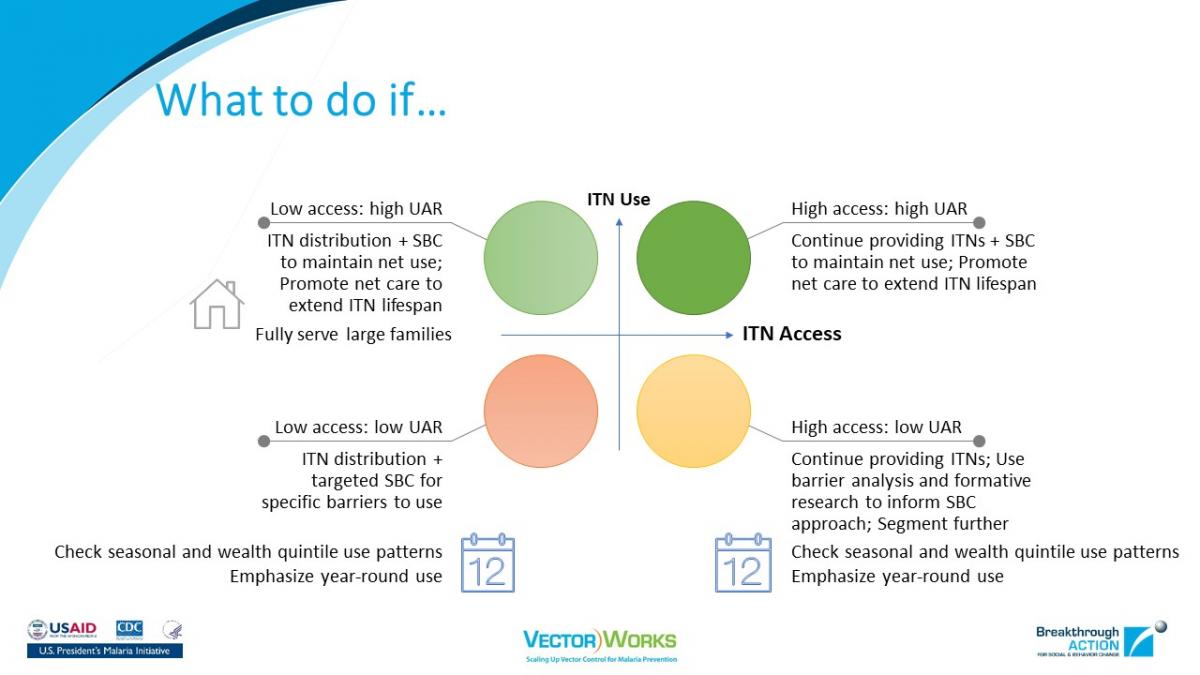Use of insecticide-treated nets (ITNs) is one of the main interventions to prevent malaria, and high ITN use rates are a central goal of malaria programs. The four standard indicators to assess outcomes have assessed the percentage of: 1) households owing at least 1 ITN, 2) population with access to an ITN within their household, 3) households owing at least 1 ITN for every 2 people, and 4) population that used an ITN the previous night.
It is common for countries to find a gap between ownership of at least 1 ITN and % people that used an ITN the previous night. This “net use gap” is often referred to by program planners when looking at the standard indicators of household ITN ownership and population ITN use.
However, the population ITN use indicator does not take into account whether there are enough ITNs in the household. To better understand ITN use among those with access, we use a new indicator:
- The proportion of the population that used an ITN the previous night (numerator)
- The proportion of the population with access to an ITN within their household – these are people who could be using a net (denominator)
The ratio of people who used a net to those who could use a net provides a more accurate representation of the net-use gap, and sheds light on net use behavior. On the whole, over 80% of those with access to an ITN within their household reported using an ITN the previous night.
This has significant implications for planning behavior change interventions to increase ITN use. Previous interpretations of the net use gap as a failure of behavioral change communication interventions may not be justified, if that gap is instead primarily driven by lack of intra-household access to ITNs.
SBC needs vary depending on what the audience segment needs – greater distribution, more consistent use, improved care of nets for extended lifespan, or other needs. As indicated in the image below, taken from a presentation listed on this page (Understanding ITN Use: What do your numbers really mean?) the SBC needs around ITNs can vary widely, and segmenting groups appropriately allows programs to bring greater focus and tailoring to their SBC activities:

In this Trending Topic we provide journal articles and presentations explaining the ITN use:access ratio and provide social and behavior change (SBC) tools and project examples relating to net distribution and net use. We especially focus on the SBC areas noted in the graphic above:
- Maintaining net use
- Barriers to net use
- Promoting net care
- Formative research
- Utilizing season and wealth quintile use patterns
- Emphasis on year-round use
We welcome your contributions to this topic! If you have articles, tools, or other materials you’d like to share, please contact the Health COMpass curator, Suisan Leibtag, susan.leibtag@jhu.edu.
Journal Articles
GENERAL
- Koenker, H. et al. (2018) ITN Access and Use Report. Vector Works.
- Koenker, H. et al. (2014) Recalculating the Net Use Gap: A Multi-Country Comparison of ITN Use versus ITN Access. PLOS One. Vol. 11, No. 8.
DETERMINANTS OF NET USE
- Diema, K.K., et al. (2017) Barriers to sustained use of the insecticide-treated bed net in the upper east region of Ghana. International Journal of Community Medicine and Public Health, Vol. 4, No. 2.
- Babalola S. et al. (2016) Correlates of Intra-Household ITN Use in Liberia: A Multilevel Analysis of Household Survey Data. PLoS One, Vol., No.
- Strachan C.E. et al. (2016) What drives the consistent use of long-lasting insecticidal nets over time? A multi-method qualitative study in mid-western Uganda. Malaria Journal. Vol.15, No.44.
- Russell C.L. et al. (2015) Determinants of Bed Net Use in Southeast Nigeria following Mass Distribution of LLINs: Implications for Social Behavior Change Interventions. PLoS One, 10(10), e0139447.
- Ouédraogo, L.T. et al. (2013) Determinants of long-lasting insecticidal net use in Burkina Faso after a mass distribution in the Diebougou health district. Revue d’Épidémiologie et de Santé Publique, 61(2), 121-127.
- Awosan, K.J., et al. (2013) Prevalence and barriers to the use of insecticide treated nets among pregnant women attending ante-natal clinic at Specialist Hospital Sokoto, Nigeria. Journal of Public Health and Epidemiology. Vol.5, No.10.
- Community health workers’ perceptions of barriers to utilisation of malaria interventions in Lilongwe, Malawi: A qualitative study. Malaria World Journal, Vol. 3, No. 11
NET CARE AND REPAIR
- Zwede, Ayele, et al. (2017) Knowledge and perception towards net care and repair practice in Ethiopia. Malaria Journal, Vol. 16, No. 396.
- Hunter, Gabrielle, et al. (2014) “We are supposed to take care of it”: a qualitative examination of care and repair behaviour of long-lasting, insecticide-treated nets in Nasarawa State, Nigeria. Malaria Journal, Vol 13, No. 320.
- Loll D.K. et al. (2014) “You need to take care of it like you take care of your soul”: perceptions and behaviours related to mosquito net damage, care, and repair in Senegal. Malaria Journal. Vol.13, No.322.
- Leonard L. et al. (2014) Net use, care and repair practices following a universal distribution campaign in Mali. Malaria Journal. Vol.13, No. 435.
Banner photo: A child sits under a mosquito net in Buhigwe, Tanzania. © 2017 Magali Rochat/VectorWorks, Courtesy of Photoshare



